Leaving Langar
On my second morning in the Wakhan we got ready to leave Langar, and Megi's language skills came in handy once again. It turned out that one of Yodgor's relatives would be heading down the valley later in the morning, so we arranged to have him pick us up from the side of the road as we started ahead of him.
It was only while we were leaving that we discussed money with Yodgor, and when we asked him how much we owed him, he suggested 30 somoni per night–including breakfast and dinner–but said that if we thought this was too much we should say so. This is a screaming deal compared to prevailing rates at tourist-board-affiliated homestays—which are around $10 (45 somoni at the time) for a place to sleep, with meals adding another $5-$7 per day—so I was perfectly happy with his prices... and happy to recommend him to anyone staying in Langar. Of course the facilities are a bit more basic than at more tourist-oriented homestays (expect breakfast to be the
shir choi that is a staple of local diet—bits of old, hard bread mixed with back tea, milk, and butter), but Yodgor is friendly and honest.
 |
| Panorama of the Wakhan valley to the west of Langar. |
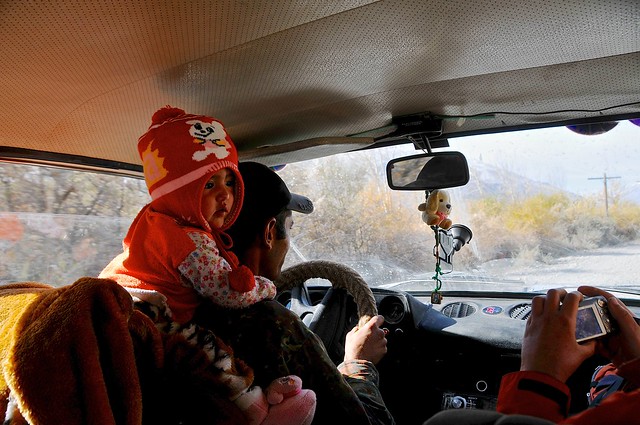 |
| Tajik car seat. Rather like a 1970's western car seat, except the kid is way cuter. The car was a Lada Niva, which is like a 4-wheel-drive version of a 1970s VW Golf/Rabbit—a model which has been in continuous production since 1977. Just about every old car is equipped with an mp3 player that accept tiny micro-SD cards, and it can be comical to be bumping along horrific roads in an ancient vehicle driven by a rough and tough local who starts fumbling with a tiny little memory card between his fat, callused fingers when he decides to switch up the music. |
We were dropped off in the village of Vrang, which is notable mainly for a five-level stepped pyramid which is usually described as a Buddhist stupa, but which some think
may originally have been a Zoroastrian fire-worship platform—it definitely doesn't look like any other Buddhist stupa you're likely to see. Regardless of its original purpose, the structure was used for Buddhist purposes at some point in its history, and their are monks' caves built into the stupa's foundation—and apparently there are
more caves on the other side of the Pyanj in Afghanistan, where a monastery was also located.
 |
| We were dropped on the main road through Vrang, from which it is a short walk through the fields to the Buddhist or Zoroastrian stupa/pyramid on a salt-dome above the village. |
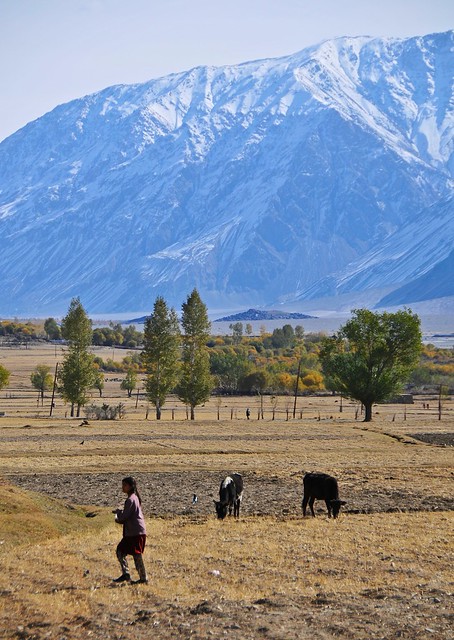 |
| A Pamiri girl in the fields. |
As we walked through the village towards the pyramid which towers over the village, Megi and I were approached by a girl of perhaps twelve who offered to show us the way and guide us around the village. This sort of thing is very common in Southeast Asian countries like Cambodia and Burma, where there are kids at local temples and caves who will tag along and show you the path or point things out with their flashlights, all in the hope of getting a tip at the end. I didn't know if this was the same sort of setup, but I suspected it might be, especially since the Lonely Planet section on Langar indicated people would expect to be paid for guiding you to the petroglyphs there. That being the case, I largely left Megi and the girl to walk together and chat, which was relatively easy to do since could talk pretty easily in Tajik.
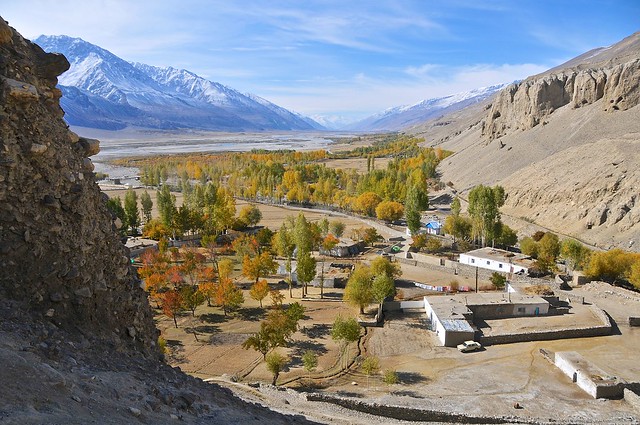 |
| The best way to the pyramid is to curve around the base and enter from the side. This approach lets you take a look at the (inaccessible) Buddhist caves built into the pyramid's foundation, which you can see on the left. |
 |
| Panorama from above the pyramid, with the ruins of an old fort above the pyramid. |
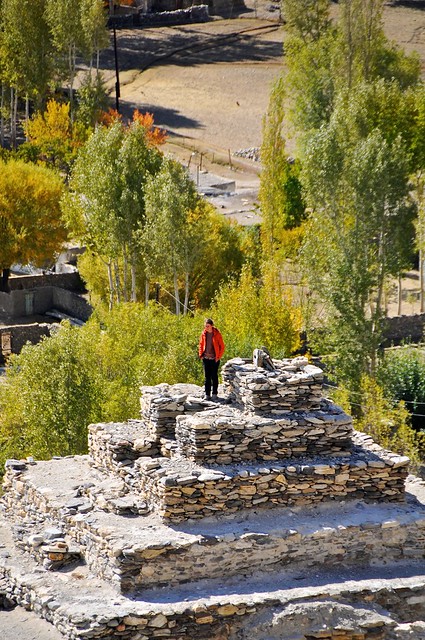 |
| Megi on the pyramid. We both had jackets the same shade of orange. |
 |
| Panorama from the other set of ruins. |
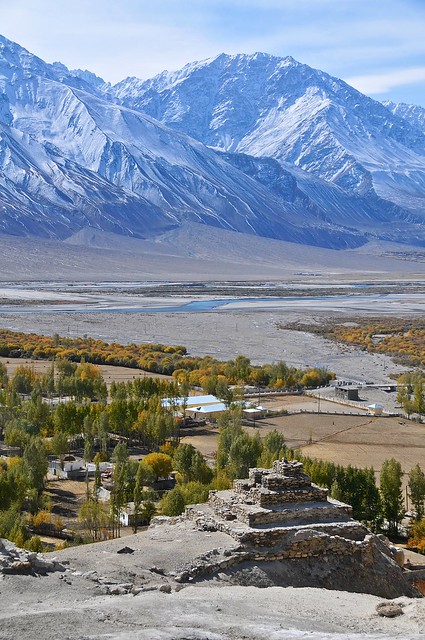 |
| Pyramid, Vrang, Pyanj, Afghanistan, Hindu Kush. |
 |
| The pyramid probably looked like fort ruins on the left before it was restored. |
 |
| Mornings don't get much better than this. |
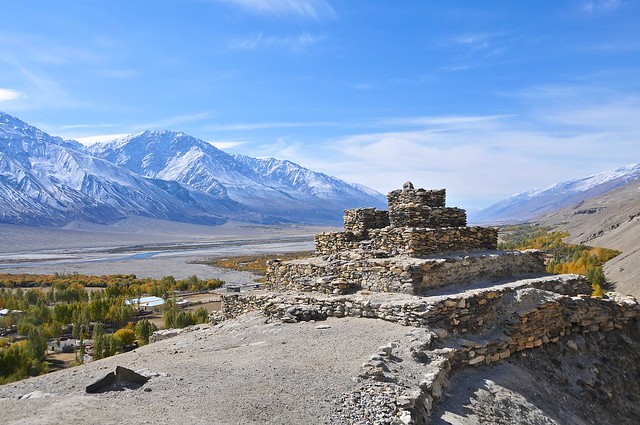 |
| Looking towards Ishkashim. |
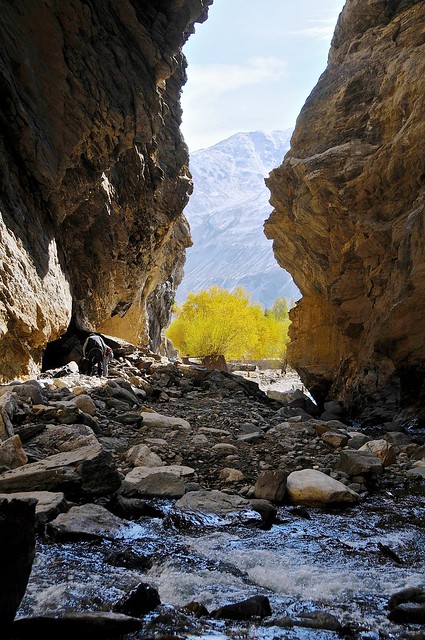 |
| Just to the side of the pyramid base is a small canyon. On the left you can see a couple of guys doing some maintenance on one of the irrigation channels leading from the stream. |
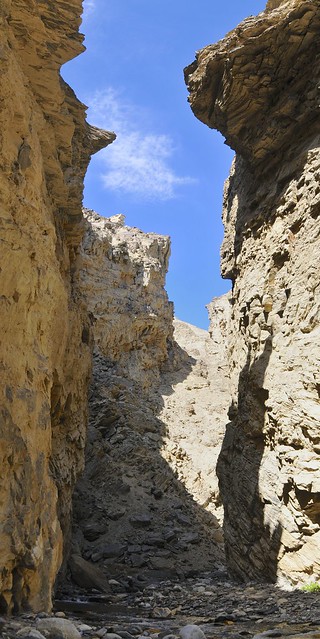 |
| Looking up the canyon. Just around the corner it ends in a steep slope. |
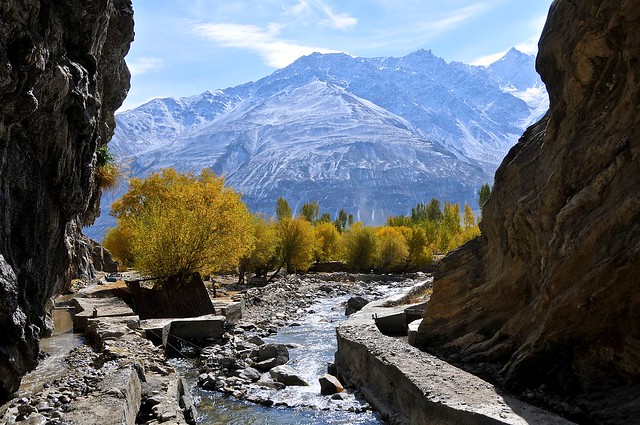 |
| The canyon outlet, with channels on either side diverting water for irrigation and household use. |
The local girl stayed with us throughout our time at the stupa, and guided us down into the canyon as well, which made me rather suspect that she was indeed looking for a tip. But when Megi offered her one as we prepared to leave Vrang, the girl was honestly a bit aghast and declined the offer. In retrospect, this is completely unsurprising, even though the region is desperately poor.
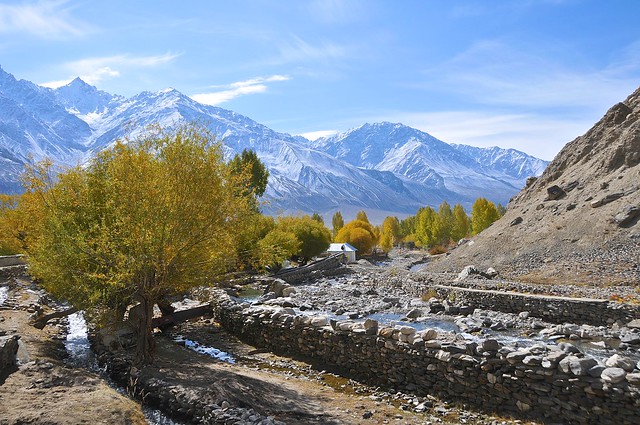
 |
| The start of the village, with the raised irrgation channel and stream on the right. On the left you can see the caves in the side of the pyramid foundation. |
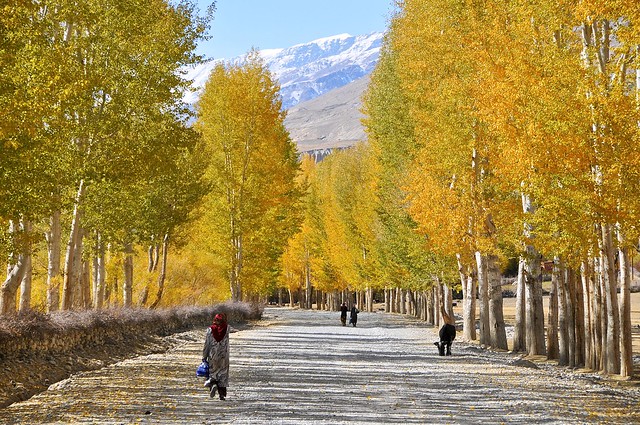 |
| Main street, Yamg. |
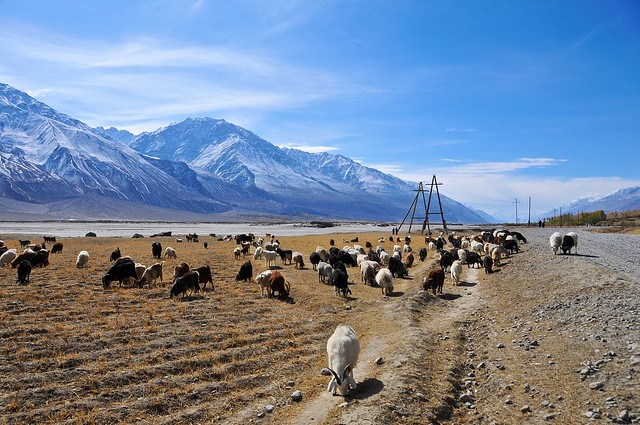 |
| Small livestock on the road between Vrang and Yamg. |
 |
| The Hindu Kush reflected in a small backwater next to the Pyanj, between Vrang and Yamg. |
 |
| Afghanistan is but a stone's throw away. |
We entered Yamg, where we planned to stay the night, around noon. A local quickly pointed us in the direction of a homestay just off the road. It turned out to be the homestay of Aydar Malikmamadov, who is also the custodian of the local museum (which actually looks very interesting, and I'm sorry we didn't see it while we were there). He used to be a schoolteacher in Yamg, and he's definitely one of the more prosperous members of the community, as he has his own Japanese Pajero SUV and his family apparently runs two different homestays in town. Megi and I had the choice of staying in the main building, in a more authentic family style, or staying in the purpose-built tourist wing on the other side of the courtyard. He had four guest rooms built there—all of which were just plain and empty rooms with kurpachas to put on the floor—as well as a sparkling bathroom with a western-style flush toilet (very surprising), although the shower was in an older room across the courtyard next to the entrance. We each took a room in the new wing.
 |
| The tourist wing of Aydar's main homestay. |
Aydar even had business-card style slips of paper with his contact information printed on them—a surprisingly entrepreneurial touch, although compromised by the poor copying which resulted in them being somewhat difficult to read. For those interested, however, here is his contact information:
Malikmamadov Aydar
Yamg Village
N 36°58.861, E 72°19.131
tel: 992 93 45 65 519
email: aydarmamad@mail.ru
After dropping our bags, Megi and I headed west towards Yamchun Fort and Bibi Fatima hotsprings. We followed the river and the main road for a while, then took a path that skirted its way up the valley slopes. We ran into a few locals who invited us in for tea, but declined since daylight is limited in late October.
 |
| Another reflection from just west of Yamg. The water is only a few inches deep. |
 |
| A random fort partway up the valley that we happened upon by chosing to walk on the paths above the valley, and not simply following the main road through the valley. |
 |
| The walk is just one long, unending stretch of amazing views. |
 |
| Near the fort. |
 |
| A lower guard tower for Yamchun fort, overlooking the valley. |
 |
| The fort sprawl across several levels. |
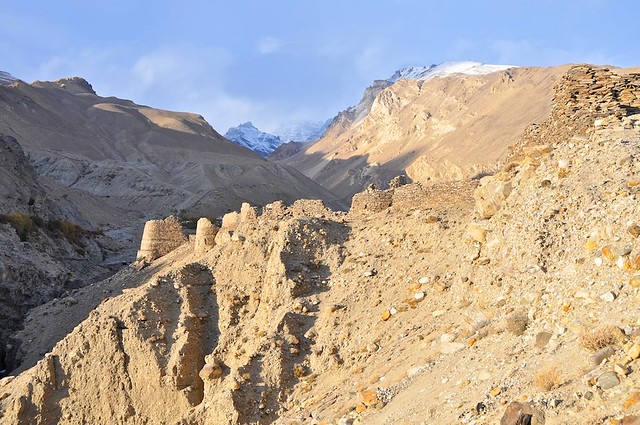 |
| Looking north from one section of Yamchun to the other. The Bibi
Fatima hotsprings are in the valley directly behind the fort.
Yamchun is well located, as it is on a little hill that is isolated in
all four directions, including from further up the valley. |
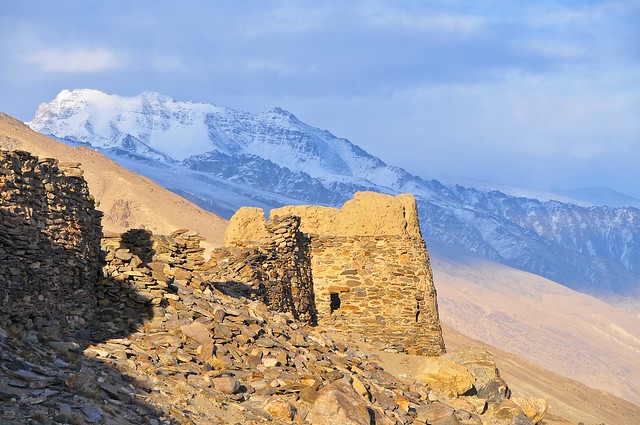 |
| I wonder how much of the surviving fort is actually the result of reconstruction and restoration. I suspect lots of work has been done, but it has been done very sympathetically. |
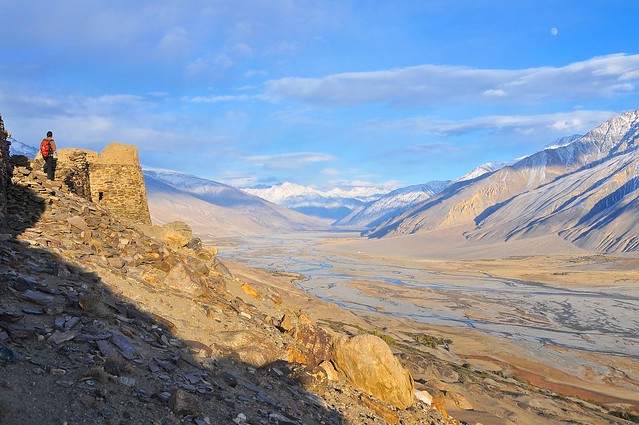 |
| Looking East up the valley. Langar would be at the very end. |
 |
| View from the edge of Yamchun. |
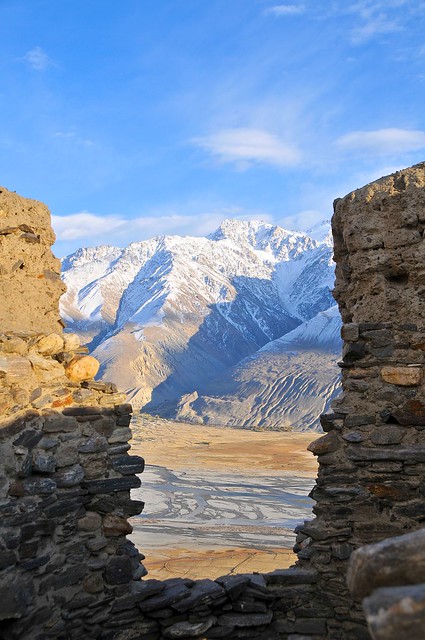 |
| The Pyanj river and the HIndu Kush through the ramparts. |
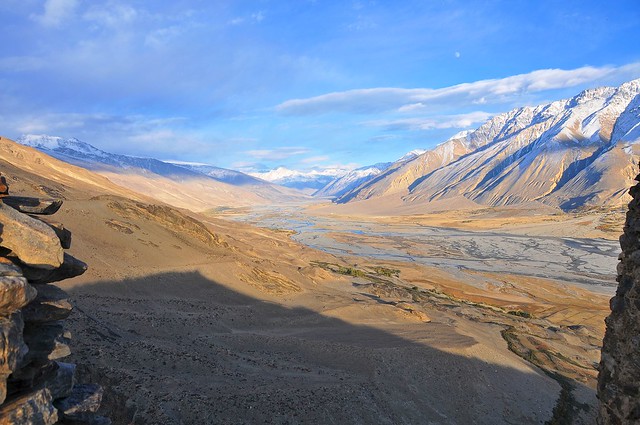 |
| The fort casts a long shadow over the valley —literally. |
 |
| Panorama from inside Yamchun fort. |
|
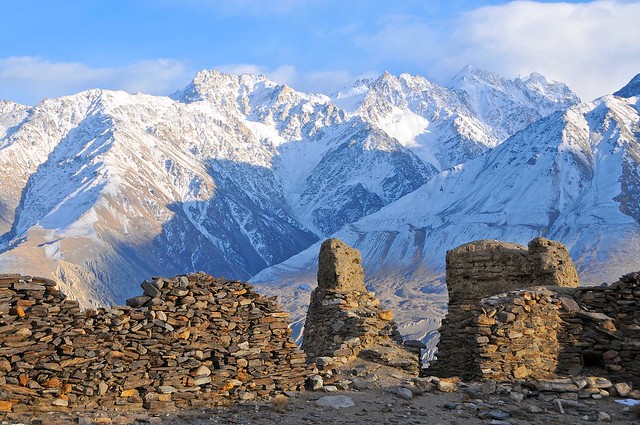 |
| Looking over the Hindu Kush. |
 |
| In this panorama looking west you can see just how sprawling the fort is, as high ground to the south and north are connected. |
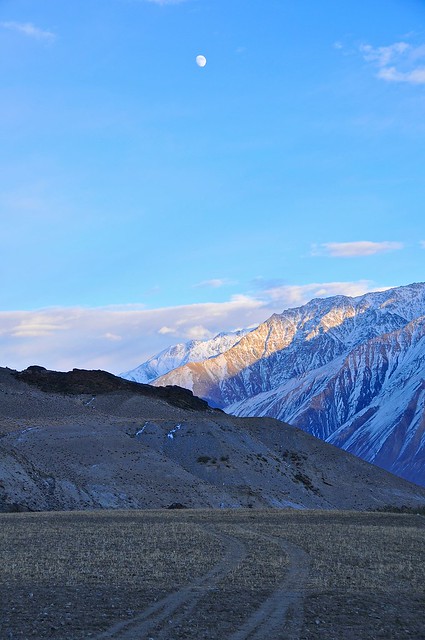 |
| Field, moon, and mountains from near Bibi Fatima. |
Although the sun was setting, we headed up to Bibi Fatima hotsprings after Yamchun. Although the springs are directly behind the fort, they're further up the valley than you might expect (there's a large compound deceptively on a plateau, but the springs are actually farther up the road in the crook of the valley, where water naturally flows). On our way we ran into the caretaker of the springs, who was very friendly and talked to us (well, to Megi in Tajik, really) and invited us to stay with his family for the night. Of course, we had already left our stuff at the homestay in Yamg, so we declined. Once at the springs they let us go take a look, even though we weren't going to bathe. The springs are typically segregated by sex, with them being open for a few hours for men then a few hours for women. The actual springs looked pretty depressing to me, as they were simply a square concrete pool at the bottom of a sunken two-story building/shack, with windows only on the second floor. But it seems that if you actually descend to the springs,
they are actually quite nice, as there are natural rock formations in the outdoor pools.
The sun had set by the time we finished looking around, and since we were some distance from Yamg we were in a bit of a hurry. And since the main road down the valley from the hotsprings runs to the west of Yamchun fort before joining up with the main road where we would turn east, I thought it made sense to take one of the trails straight down the valley that the hotsprings was in, the return to Yamg the same way had left it, by skirting the main Wakhan valley.
Unfortunately, this turned out to be a more difficult route than anticipated, as the trails down the valley required some steep scrambles down, and then towards Yamchun they led back up some equally steep slopes. And in order to get on the eastern side of this valley, where we hoped there would be an outlet to the main valley that didn't involve climbing, we had to find a place to cross over a fast-moving stream. We managed to find a place to cross that involved a bit of jumping from boulder to boulder across the stream, then walking along an irrigation dike, which eventually deposited us fairly high up the valley. But even there it was still a chore to get back, as although there were isolated fields being cultivated up there, they were separated by thick bushes, and the trails between them seemed to be used mainly by animals and not humans, which meant they were goat-sized and prickly. It was getting quite dark now and, based on the alarm I had caused in Jeti Oguz, I was worried that our hosts in Yamg would begin to get worried about us since we were out so late. We finally made it back well after dark, and were pleased that we hadn't caused any undue concern—though Aydar said that if we hadn't returned in another half an hour or so he probably would have gone looking for us.
That night we had dinner with Aydar and his family in the main house. Though I didn't know to look out for
distinctly Pamiri design elements at the time (e.g., skylights recessed in four tiers, and main rooms supported by five pillars), in retrospect the layout of his main room does seem to match descriptions of traditional houses.
Earlier in the day, when we first arrived in Yamg, we had come across a group of schoolkids. One of the kids immediately stood out, as she was wearing glasses. This was pretty surprising, because I don't think I had seen
any children in Central Asia wearing glasses, and the fact that it was a female who was wearing them was even more surprising—implying as it did the fact that it was important for girls to see, read, learn, and that it was worth spending money on them.
Now, at dinner that night I discovered that the bespectacled girl was Aydar's daughter. This simply reinforced my ideas about how progressive and forward thinking he was, even for an already progressive Pamiri, and was heartening to see. Over dinner conversation returned to a common theme in Tajikistan: the economy and standards of living. Aydar made the familiar observation that life under Soviet rule was more comfortable, with better infrastructure and services—electricity, for example, used to be reliable and outages fixed quickly, in contrast to the current situation. And while it's possible that the neglect and deterioration is just a function of being in rural, isolated communities, as in the Fann mountains, the perception certainly exists that the Pamiris are being neglected for political reasons.
As in Langar, we only talked money when it came to departing, and Aydar asked for 50 somoni inclusive of all food. Based on what we paid in Langar, Megi thought about negotiating, but I thought it was a fair price given that official homestays charge that much simply for a place to sleep, so we accepted the price (though I think it would have been possible to get a discount). Aydar also arranged for us to get a ride into Ishkashim, which was helpful.
Budget
October 25, Langar to Yamg: 75 somoni
- Taxi to Vrang: 25 somoni
- Room and board: 50 somoni






































Thanks for sharing an information to us. If someone want to know about Cottages and reorts. I think this is the right place for you!Cottages Resorts
ReplyDelete